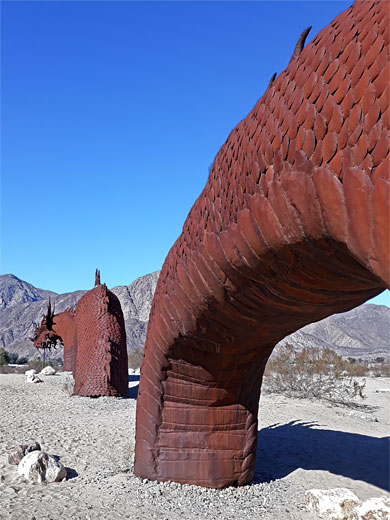Galleta Meadows Sky Art, Borrego Springs
California > Anza-Borrego Desert State Park > Galleta Meadows Sky Art
Highlights:
Over 100 iron sculptures in the flat desert around Borrego Springs, created by artist Ricardo Breceda, from 2007 onwards; themes are fantasy creatures, extinct animals, and the history and wildlife of the surrounding area
The color of the ironwork is rich red/brown, partly the result of weathering beneath the desert sun, and the figures blend in quite well with the dusty brown desert, which otherwise is covered only by scattered bushes - there are no trees, and very few cacti. The artwork has in recent years become a major visitor attraction, partly as it is easier to see and approach than the many more hidden natural attractions of the area; all the surroundings are part of Anza-Borrego Desert State Park, whose features include narrow canyons, palm oases, riparian valleys, historic sites, old mines, badlands and springs.
The desert where the sculptures are located may seem to be typical undeveloped public land but it is in fact privately owned, part of the Galleta Meadows Estate, property of the Avery family. The artwork was created by the then owner Dennis Avery (died 2012), via a long-running commission with Richard Breceda, a sculptor from Aguanga. Besides providing a backdrop for the artwork, the land is intended for conservation purposes, though remains open to the public without restrictions, for uses including camping, hiking and horseriding.
Galleta Meadows Table of Contents
Map of the Galleta Meadows Sky Art

Southern Group of Sculptures
Although there are 130 sculptures in total, this figure includes separate counts for installations with two (or more) elements; the pieces occupy about 40 individual sites, and can be seen in around half a day. All are close to paved roads, within 800 feet, apart from the southernmost group, consisting of several dinosaurs, these one mile down a sandy track. The track starts from Borrego Springs Road, in the middle of the southern group of figures, which include a 'wind god bird' (aiolornis incredibilis, from the Pleistocene epoch), an elephant and various horses on the north side of the road, and sabertooth cats to the south. There is one sculpture in the downtown area, at the entrance to the Borrego Springs Welcome Center, just east of Christmas Circle; this is of Juan de Anza, the Mexican explorer after which this region is named.
Northern Group of Sculptures
The northern artwork group begins along Borrego Springs Road just south of the intersection with Big Horn Road - around here are camels, a scorpion and grasshopper, a peccary, a tapir, a dinosaur, and the 'vineyard', this with about 12 separate designs, of people and vines. A short distance north is the most famous sculpture, the serpent, which is in five parts, head and two body sections on the west side of the road, another segment and the tail east of the road. A little further west, along San Ysidro Drive, is a group of camels and llamas, while the final collection is 0.7 miles north, where Borrego Springs Road curves east and becomes Henderson Canyon Road. Designs hereabouts include bighorn sheep, elephants, a jeep, a prospector on horseback, a Spanish padre, a desert tortoise and an Indian head.
All Contents © Copyright The American Southwest | Comments and Questions | Contribute | Affiliate Marketing Disclosure | Site Map














